thanks, erik. a real wood cabinet would be nice. i'll keep my eyes open for a vintage one at Goodwill. you'll often find a pair with worn out or dented drivers.
Hi Keilau. I just bought a pair of these Cue-5 speakers and am hoping you're still available to answer a few questions:
1. What did you think of them when they just had the 3.3 uf capacitor?
2. How did your mod improve the sound?
3. Now that you've had them a few years, would you say it is worth my time to duplicate your mod? If so, any additional specifications you can off on ordering the parts would be helpful.
Thank you.
I did some causal listening when I first received the Hosa, may impression was very favorable:
- The bass was well extended for such a small box without sounding boomy. I wrap some 3M sound dampening pad around the flat shaped vent tube. But leave the box alone because it is a very sturdy box with thick MDF.
- The overall frequency response was quite smooth and well extended at the high end.
- The mid range is the rough spot and there was not much sound staging to speak of.
- I found the drivers to be very high quality and decide that the lack of a proper crossover was the limiting factor. I am pleasantly surprised that does not have a resonance peak at the 5-6 KHz range which made the crossover design very easy.
I found the Hosa "as is" (simple 3.3 uf capacitor) sounds better than many commercial offer up to $300 range due to the quality of its drivers and cabinet construction. The original Hosa was sold as a small studio monitor with built in amp at $800. But it was before its time and did not sell well.
Is my mod worth it? Definitely yes, particularly consider the cost and time. (But, of course, I am biased)
I recently finished 2 pairs of bookshelf. I usually prefer closed box for its more natural sounding bass/lower-midrange. Both use the Peerless 830875 6.5" Nomex woofers. One use the Dayton Audio RS28A-4 and the other use Seas 27TBF/G. They have more elaborated crossover design and cost quite a bit more.
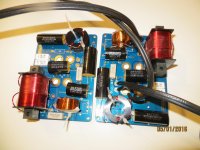
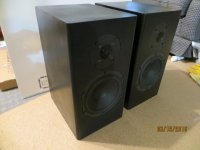
You can find more information about my other project at this thread:
http://www.diyaudio.com/forums/multi-way/278728-crossover-modest-diy-bookshelf-speaker-project.html
hi K.
in your first post you mentioned the tweeter was unmarked but in your schematic you identified it as SEAS 22TFF. Is that correct or did you replace the driver?
do you remember where you bought the parts?
in your first post you mentioned the tweeter was unmarked but in your schematic you identified it as SEAS 22TFF. Is that correct or did you replace the driver?
do you remember where you bought the parts?
Last edited:
Not necessarily true. Possibly, maybe, true for a simple unambitious 2-way.
Definitely not true for TOTL state-of-the art systems.
M.
You can find good 2 way systems with a single cap. They are like the Chupacabra though. Sometimes whispered about and seldom seen. 🙂 Don't dismiss it out of hand.
Whether by choosing drivers or crossover parts or cabinets, it's all a balancing act. Simple designs may work magically. OR suck. 😀
Erik
hi K.
in your first post you mentioned the tweeter was unmarked but in your schematic you identified it as SEAS 22TFF. Is that correct or did you replace the driver?
do you remember where you bought the parts?
I am sorry about the confusion. The tweeter used was what comes with the Hosa system. It is NOT a "SEAS 22TFF". The name in the header was a carryover from a previous project when I run the PCD program.
I created the FRD and ZMA file for the Hosa drivers myself using simple measurement with a calibrated microphone and the ARTA program. It was done quickly in my basement room and ARTA saved the files for the PCD use. Not the most scientific approach, but good enough for a weekend project. Most importantly, the listening result seemed to validate the measurements.
I tried the SEAS 22TFF and the Seas 22TBF/G in a Wharfedale M138 modification. The crossover is interchangeable. I did not try to tame the 3dB rise above 11KHz because it is small and not there off axis.
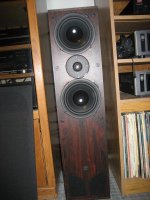
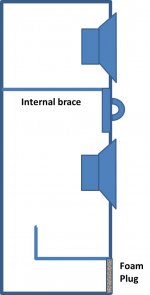
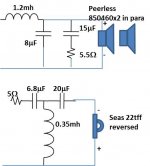
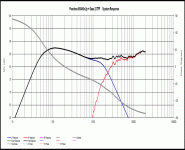
Sonny,
I don't know what Erik was talking about when he mentioned padding resistors. He seemed to created something with no knowledge of the Hosa drivers. On the Hosa, the woofer and tweeter output are pretty well matched. I don't know what woofer was Erik talking about in Post #8, but it has no relevance to the Hosa that we are discussing on this thread.
My mod is a low cost weekend project. If you want something higher quality, buy a kit with matching crossover and drivers. The Dayton Audio RS621CCK at Parts Express (with pre-finished cabinet) and the Continuum at Meniscus (w/o cabinet) come to mind. They are not much more expensive than the Bookshelf project I mentioned earlier.
If you are interested in what people has to do to design their own speaker, Paul Carmody has an excellent tutorial here.
I don't know what Erik was talking about when he mentioned padding resistors. He seemed to created something with no knowledge of the Hosa drivers. On the Hosa, the woofer and tweeter output are pretty well matched. I don't know what woofer was Erik talking about in Post #8, but it has no relevance to the Hosa that we are discussing on this thread.
My mod is a low cost weekend project. If you want something higher quality, buy a kit with matching crossover and drivers. The Dayton Audio RS621CCK at Parts Express (with pre-finished cabinet) and the Continuum at Meniscus (w/o cabinet) come to mind. They are not much more expensive than the Bookshelf project I mentioned earlier.
If you are interested in what people has to do to design their own speaker, Paul Carmody has an excellent tutorial here.
Last edited:
Keilau,
I was going from the idea it was a Seas tweeter, but looking at your chart, I wonder if the same doesn't apply. The upturned curve is a result of the alignment of the HP filter. I do wonder if it wouldn't have been better to add a resistor and align different, but I have no original data to go by.
Sorry!
Erik
I was going from the idea it was a Seas tweeter, but looking at your chart, I wonder if the same doesn't apply. The upturned curve is a result of the alignment of the HP filter. I do wonder if it wouldn't have been better to add a resistor and align different, but I have no original data to go by.
Sorry!
Erik
It makes sense.... I did not try to tame the 3dB rise above 11KHz because it is small and not there off axis.
What's a TOTL system?🙂Not necessarily true. Possibly, maybe, true for a simple unambitious 2-way.
Definitely not true for TOTL state-of-the art systems.
M.
- Status
- Not open for further replies.
- Home
- Loudspeakers
- Multi-Way
- Hosa Technology Cue-5 Monitor Speaker driver information